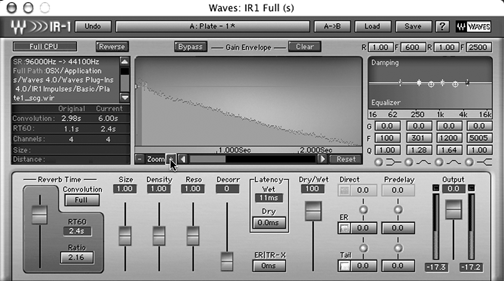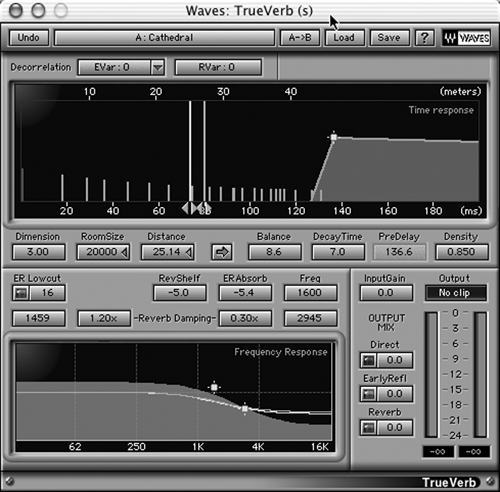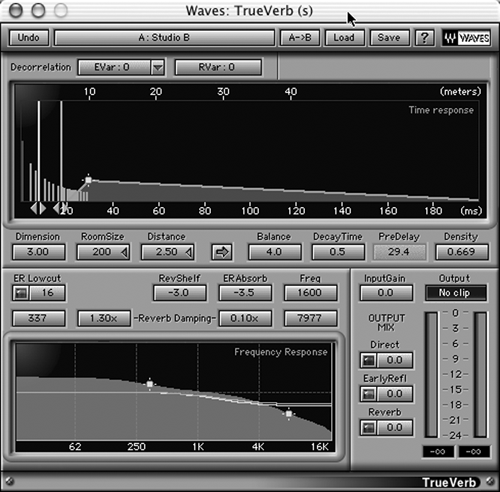by Steve Cunningham
Reverb is one of the cool tools of production. Everyone has a favorite model of reverb, and perhaps several of them. They serve to create the illusion of space, they can warm up dry tracks, and occasionally get used to hide sonic warts, particularly in music beds. They’re great fun to use and sometimes abuse.
Like many of our other tools, digital hardware reverbs are being replaced with software plug-ins. For the most part these plugs do a good job substituting for their rackmount forebears. But until very recently, few would mistake either software or the hardware reverbs for the effect of recording in an actual acoustic space. They give the impression of a space, but certainly don’t “model” it. Enter convolution reverberators.
The Waves IR-1 is a stereo convolution reverb that uses Impulse Response technology to actually “model” a physical space, rather than try to mimic it using conventional reverb parameters. Before we go any further, let’s look at how this works.

SIMULATING SPACE
Digital reverb has been with us for over twenty years, replacing our old mechanical spring and plate devices and allowing us to simulate a wide variety of acoustical spaces. But the simulation has always been just that, creating the illusion of a space by approximating some of the natural properties of room acoustics.
To understand how the illusion works, we need a bit of acoustic theory. Reverberated sound can be broken down into three components: the direct signal that travels straight from the source to our ears, the first few early reflections that bounce off major boundaries in the space before reaching our ears, and the reverberation itself, which is sound that has bounced off multiple surfaces many times before it gets to us. Unlike the early reflections, these later random reflections are so closely spaced that our brain can’t discern them as individual reflections anymore, and they are instead perceived as a single decaying sound.
It is the few early reflections, which we perceive as echoes and are collectively called pre-delay, that give us the best subconscious cues as to the size of a room. Recalling that sound travels at 1130 feet per second, if the time between the arrival of the direct sound and the arrival the first early reflection is 100 milliseconds (a tenth of a second), then that first reflection had to travel a 113 feet farther than the direct sound to get to our ears. Our brain tells us that we’re probably in a large room. If the arrival time difference is smaller, then our brain tells us we’re in a smaller room. And if we’re in a very small room we may not perceive the early reflections at all, since most people can’t hear delay times of less than about 25 milliseconds discreetly. At that level the first reflections just seem to be part of the direct sound.
In a similar fashion, if there are lots of distinct early reflections, then we instinctively deduce that the large room is mostly empty. If there are fewer early reflections, then we sense that the room contains objects that diffuse those reflections and cause them to smear together.
The reverberated component gives us further clues about the size of the room, and what its surfaces are made of. When the reverb decay time is long and the reflected sound closely resembles the original sound, we know two things — we’re in a large room, and the walls, floor, and ceiling are probably hard surfaces. Think about the sound of a bouncing basketball in a gymnasium, how bright the echoes of the bounce are, and how long they take to die out. But if we bounce the same ball on the same hardwood floor in a big theater with seats and drapes, the decaying sound will lose much of its high frequency content as the fabric and furniture in the room soak up the treble portion. The reverb “tail” may last as long, but it will sound duller than the original bounce sound.
Finally, the ratio of direct sound to pre-delay and reverb tells us how far the original source sound is from us. The louder the direct sound portion is, the closer the sound source is to our ears. Look at Figures 2 and 3, both of which display the parameters available on a conventional digital reverb plug-in. Figure 2 shows a Cathedral program, while Figure 3 is a program to simulate a small recording room. Notice the spacing of the early reflections, the time and intensity of the reverb portion, and the EQ curves. All of these contribute to creating the audio illusion of space.
For the past twenty-odd years, this illusion has been accomplished with digital signal processing (DSP) algorithms that roughly mimic the results of the acoustical reverberation process. But despite a wide variety of adjustable parameters, these algorithms are often simply a series of sophisticated delays combined with digital equalizers and filters. The algorithms are well-understood and quite good, but often not realistic.

CONVOLVE THIS
Convolution offers another approach to simulating physical space, in which a signal is mathematically analyzed, and its characteristics are applied to another signal. Convolution algorithms have been used in digital audio for quite awhile, and several audio editors have a convolution function either built-in or available as a plug-in. The convolution is usually used in the frequency domain, and it’s prized by sound designers for its ability to mangle sound. You copy a bit of frequency-rich sound (an impulse) to the clipboard, and then apply the convolution function to your target audio. The software then multiplies the frequency spectrum of the clipboard sound and the target sound together, reinforcing the frequencies that the two have in common. It’s difficult to describe the results, but they can range from a subtle morphing of the two to all-out sonic mayhem.
But convolution isn’t just for sound designers anymore. It’s now being used to create reverb that more accurately mimics a particular physical space, by applying an impulse response to a digital audio file using convolution.
An impulse response is the response of a system, like a room, to an impulse, such as a short sine-wave sweep, a shot from a starter pistol, or some other audio spike. When you create an impulse in a room, you can easily hear the room’s response in the form of acoustical reverberation. By recording the impulse along with the resulting room response, then removing the original impulse, you’re left with just the response.
In other words, if you record a starter’s pistol in a room, then add the same pistol sound, 180 degrees out-of-phase, to the recording you just made, the pistol sound cancels out and you’re left with just the reverb created by the room.
Once you’ve isolated the room’s impulse response, you can apply it to each sample of any digital audio file. Each sample acts like an impulse, and the cumulative effect of convolving the impulse response with all those impulses in quick succession re-creates the sound of that signal in that room.
In other words, you produce an audio spike in a meat locker, then run the recording through a number cruncher to isolate the impulse response. You then apply that impulse response to your favorite big-voice VO guy to hear him doing his big-voice thing from inside a meat locker. (Hey, bet that would work with a recording of the GM... ummm... never mind.)
The convolution calculations are complicated and need a fast processor. In fact, until recently convolution was an entirely off-line and non-real-time process. But it produces a sound that is less artificial-sounding than the traditional digital reverb utilizing filter networks, and it generates reverberation that is both dense and very smooth, with none of the looping artifacts that are sometimes present with regular reverbs.
The CPU chips in computers are now fast enough to create impulse response reverbs in real time, although the good ones will eat your CPU and leave little power for other tasks. But most of them sound good enough to actually dedicate a computer to nothing but IR reverb. Given that a good Lexicon or TC reverb costs several thousand dollars, a dedicated computer starts to look the bargain by comparison.

THE WAVES IR-1
The unit ships with just four basic reverb programs, but when you register the software with Waves they ship you two CDs containing some 60 sampled actual acoustical spaces and 60 samples of “classic” hardware reverbs. Waves’ entry into this processor category features controls like those on a conventional reverb, which allow you to adjust several parameters that are fixed on other convolution reverb plugs.
The convolution reverb category is far from new — Sound Forge and Cool Edit have both had convolution reverbs available for quite some time. Forge’s Convolution plug has been included since version 5, and Cool Edit’s was offered as an option to Cool Edit 2000 (it’s still part of the standard set of plugs that ship with Adobe Audition). However, the most current crop of IR reverbs does a noticeably better job of modeling actual physical spaces than past ones have done.
Several of these new convolution reverbs have been released in the past year, notably the Mac-only Altiverb from AudioEase, which seems one of the best (and next-most expensive at $499). Furthermore, TASCAM have announced their GigaPulse Convolution Reverb VST plug for Windows, which they project for a Q1 2004 release at a $299 retail price. Look for a complete roundup of these contenders in a future issue, but for the moment we’ll focus on the Waves offering.
STRESSING OUT
Nearly all current convolution reverbs will put a serious strain on your CPU, which will tend to limit the number of instances or copies, that you can run simultaneously. The IR-1’s system requirements for the PC include a 500 MHz P3 or Athalon processor (although a P4 will fare better), 500MB of RAM, and any version of Windows from 98SE to XP (except for NT). On the Mac side, the program wants a G4 or better (again, a G5 will show less strain), 256MB of RAM, and OSX version 10.2 or better. The plug-in is available in RTAS and AS formats for Pro Tools on both platforms, VST format for both platforms, plus DirectX for Windows and MAS for the Macintosh.
The IR-1’s interface looks like other Waves’ products, with both sliders and editable numeric readouts for each parameter. The center section contains the graphic display of both pre-delay and reverb time, although with both in shades of beige it can be hard to distinguish what’s going on at a glance. The graph shows dB on the vertical axis and time on the horizontal. The orange line above the graph controls an envelope with which you can fine-tune the reverb tail over time, and zoom buttons let you get in close to the graph.
To the left is a Reverb Time section, with a slider to set the overall length of the tail as a ratio of the original. Since the IR-1 uses samples to generate reverb, the actual RT60 decay time is fixed for each program, but can be modified with the slider. A button at the top of that section sets the maximum convolution time, which may be different than the reverb time. It’s important to note that the maximum convolution time is six seconds, effectively limiting the max time of decay to that amount. After six seconds the reverb effect stops abruptly, so you need to mind that parameter. The workaround is to use the envelope to make the tail fade sooner so you don’t hit the end of the convolution time. But setting the time to a lesser value lightens the load on your CPU.
Other unique parameters include a Decorrelation control, which increases the spaciousness of stereo reverb by, well, decorrelating the left and right outputs. It can be used to produce a pseudo-stereo output from a mono input, and generally emphasizes the stereo spread of the signal. The Resonance control reduces any resonances that show up in a given program.
Of special note is the fact that you can solo and adjust both the early reflections and the reverb tail independently... a nice touch. You can also adjust the time reference between Early Reflections and the Reverb using the ER/TR-X control. The EQ is four-band, as is the Reverb Damping controls. The difference between the two is that the EQ affects the reverb globally, while the damping changes the relative decay time for high and low frequencies.
In general, the IR-1 gives you substantially more control over reverb parameters than do other convolution reverbs, although some controls are obscure enough that you’ll have to fiddle with them to determine their effect on the sound. And fiddling with parameters gave the first indication that this program is using some serious CPU-juice. Changing any parameter results in the program recalculating the convolution, and depending on what parameter has changed this can take several seconds to complete. While it’s crunching, the display shows “Calculating” in its upper left corner. This is comforting, because when it’s re-grooving its innards to your latest change it’s sucking up enough CPU to make doing anything else somewhat difficult. Fortunately most changes take only a few seconds to process, and full control is returned to your mouse and keyboard.
ETHEREAL SOUNDS
The supplied impulse responses cover an extremely broad range of spaces, from concert halls to amphitheaters and from churches to clubs. The Sydney Opera House set is spectacular in its breadth, and the Knitting Factory IR was ideal for a concert promo I just completed. There are some fun IRs as well, including the stairwell of a skyscraper (really affected and strange), as well as the interior of a Ford Econoline van and a Lincoln Navigator. The latter gave just the right vibe to an urban music bed. All were very lush and dense, and the controls permitted some to get well over the top for effect.
This is in sharp contrast to other convolution reverbs including Altiverb, where you are almost completely dependent on the sound of the IR with little adjustment possible. The downside is that you cannot sample your own IR into the IR-1 — you’re dependent on what you’re given on CD and what you can download from the web. Altiverb lets you sample your own acoustical spaces if you’ve a mind to do so, but the IR-1 does not due to the specialized recording process they use to create responses.
There’s a clear difference between the sound of hardware digital reverbs and the IR-1. The traditional units produced reverb that sounded like they were added on top of the source rather than being part of it. The IR-1 blended seamlessly with the source material in a way that felt natural.
The IR-1 is not an inexpensive reverb plug, but it is substantially more useable and rich sounding than some of the free or included convolution reverbs out there. If you have the means, you should take it for a spin via a downloadable 14-day demo from Waves’ web site.
Waves’ IR-1 Convolution Reverb Native for Windows or Mac lists for $800. The HTDM version for Pro Tools TDM on Windows or Mac lists for $1,200. For more information in the US, contact Waves Inc., 306 West Depot Ave. Suite 100, Knoxville, TN 37917, phone 865-909-9200. For more information worldwide visit www.waves.com.
♦

